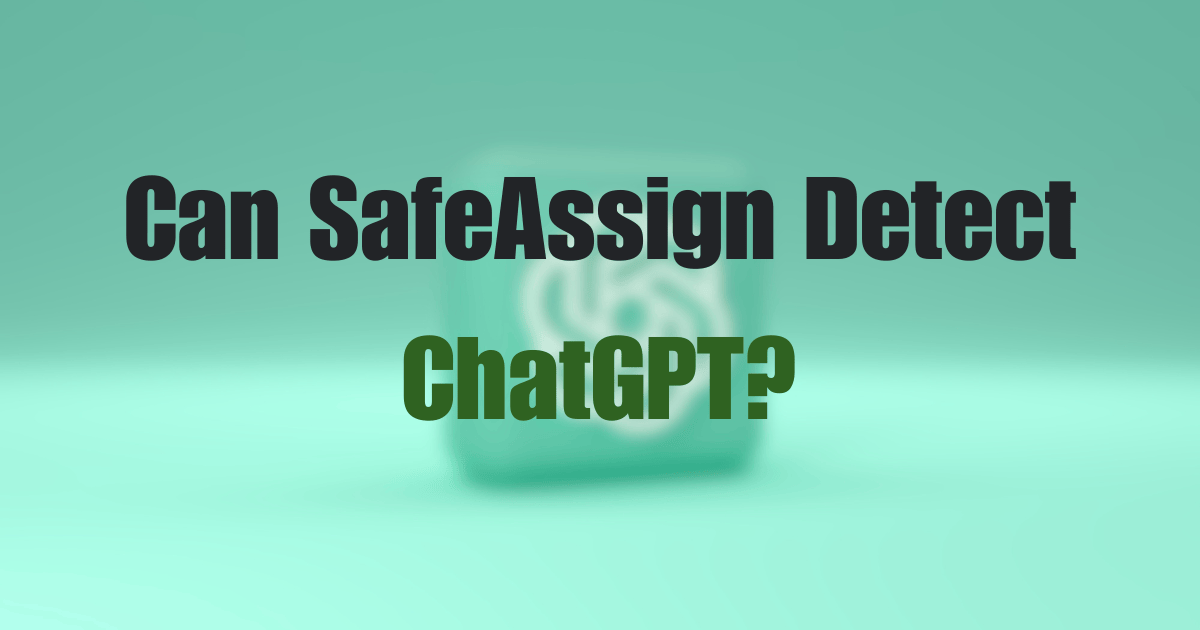

SafeAssign is a widely-used plagiarism detection tool in academia, while ChatGPT is an advanced language model developed by OpenAI. SafeAssign is primarily designed to detect instances of plagiarism in students’ papers, but it does not have the capability to detect AI-generated text like ChatGPT.
SafeAssign compares a student’s text against a database of academic papers, websites, and other relevant resources. However, it does not scrutinize writing style or nuances that could indicate AI authorship.
As ChatGPT generates unique content that is not directly copied from existing sources, it can easily bypass SafeAssign’s plagiarism detection.
SafeAssign, a widely popular tool in the academic industry, is a popular plagiarism detection system. Its primary objective is to analyze a student’s submitted text by cross-referencing it with an extensive collection of academic papers, websites, and fellow students’ submissions.
By analyzing each sentence, SafeAssign searches for matches or similarities with existing content, both within its database and on the internet.
After completing the analysis, SafeAssign generates an originality report that provides valuable insights into the paper’s content. This report includes a SafeAssign score, which indicates the percentage of the paper that matches other sources.
The originality report highlights any sections of the paper that have similarities with external sources, making it easier for instructors to identify potential instances of plagiarism.
When a student submits their paper, SafeAssign breaks it down into smaller fragments and checks each fragment against its vast database. This comprehensive analysis helps detect similarities, even if the text has been rearranged, paraphrased, or slightly modified.
SafeAssign also considers the overall structure and formatting of the document to identify copied content.
While SafeAssign is generally accurate in detecting verbatim plagiarism and identifying similarities between academic papers, it does have limitations. It may occasionally flag common phrases that are widely used without constituting plagiarism.
Additionally, SafeAssign may miss instances of paraphrased plagiarism, where students have altered the original text to evade detection.
The originality report generated by SafeAssign allows instructors to review the highlighted sections and determine if there are any concerns regarding academic integrity.
Through the use of SafeAssign, educational institutions can foster a culture of originality and ensure that students uphold ethical writing practices.
ChatGPT is an advanced AI model developed by OpenAI that utilizes deep learning techniques to generate human-like text. With its impressive capabilities, ChatGPT can produce a wide range of written content, including essays, articles, summaries, poetry, and more.
What sets ChatGPT apart is its ability to generate fundamentally unique text, making it a powerful tool for content creation.
Unlike other AI models, ChatGPT does not simply copy and paste information from its training data. Instead, it employs methods such as paraphrasing, summarizing, and creating entirely new sentences, resulting in highly creative and distinctive content.
This uniqueness poses a challenge for plagiarism detection tools like SafeAssign when it comes to identifying and flagging AI-generated text.
The main focus of SafeAssign is to identify exact word-for-word plagiarism by comparing submitted text with a database of academic papers, websites, and other sources. However, it is not equipped to detect AI-generated content that is not simply copied from existing sources.
As a result, ChatGPT-generated text can often bypass SafeAssign’s plagiarism detection.
Due to ChatGPT’s ability to generate unique content, it is crucial for students and researchers to consider the limitations and ethical implications of using AI models like ChatGPT for academic work.
While ChatGPT’s content may pass the plagiarism check, it does not guarantee the quality, accuracy, or relevance of the writing. Therefore, it is essential to critically evaluate and validate the generated text before incorporating it into scholarly or educational materials.
SafeAssign, while a widely used tool for promoting academic integrity, has its limitations when it comes to detecting AI-generated text. The focus of SafeAssign is primarily on verbatim plagiarism, comparing students’ papers against existing sources to identify direct matches.
However, SafeAssign lacks the capability to detect content generated by advanced AI models like ChatGPT.
This limitation raises important ethical considerations regarding academic integrity. As ChatGPT and similar AI models can generate fundamentally unique content, they can easily bypass SafeAssign’s plagiarism detection.
While a piece of writing may pass the SafeAssign check, it does not guarantee the quality, relevance, or originality of the content.
Students should be aware of these limitations and ethical implications when considering the use of AI-generated content for their academic work.
While it may seem tempting to rely on AI models like ChatGPT to produce essays or articles, it is important to remember that academic integrity is about more than just avoiding plagiarism detection. It is about learning, researching, and engaging with subject matter in a genuine and thoughtful way.
Ultimately, the responsibility lies with the students and educators to critically evaluate the use of AI-generated content in academia. While SafeAssign provides a valuable tool for detecting certain forms of plagiarism, it cannot fully address the challenges posed by AI-generated text.
It is crucial to maintain academic integrity by using AI models responsibly and ensuring that the content produced reflects the student’s own understanding and effort.
CloudWatt.Com is a Tech News Website where we cover many things such as Technology News, Cloud Computing, Mobile, Technology, Science, Buying Guides, Entertainment, Reviews, How To Guides, and many more.